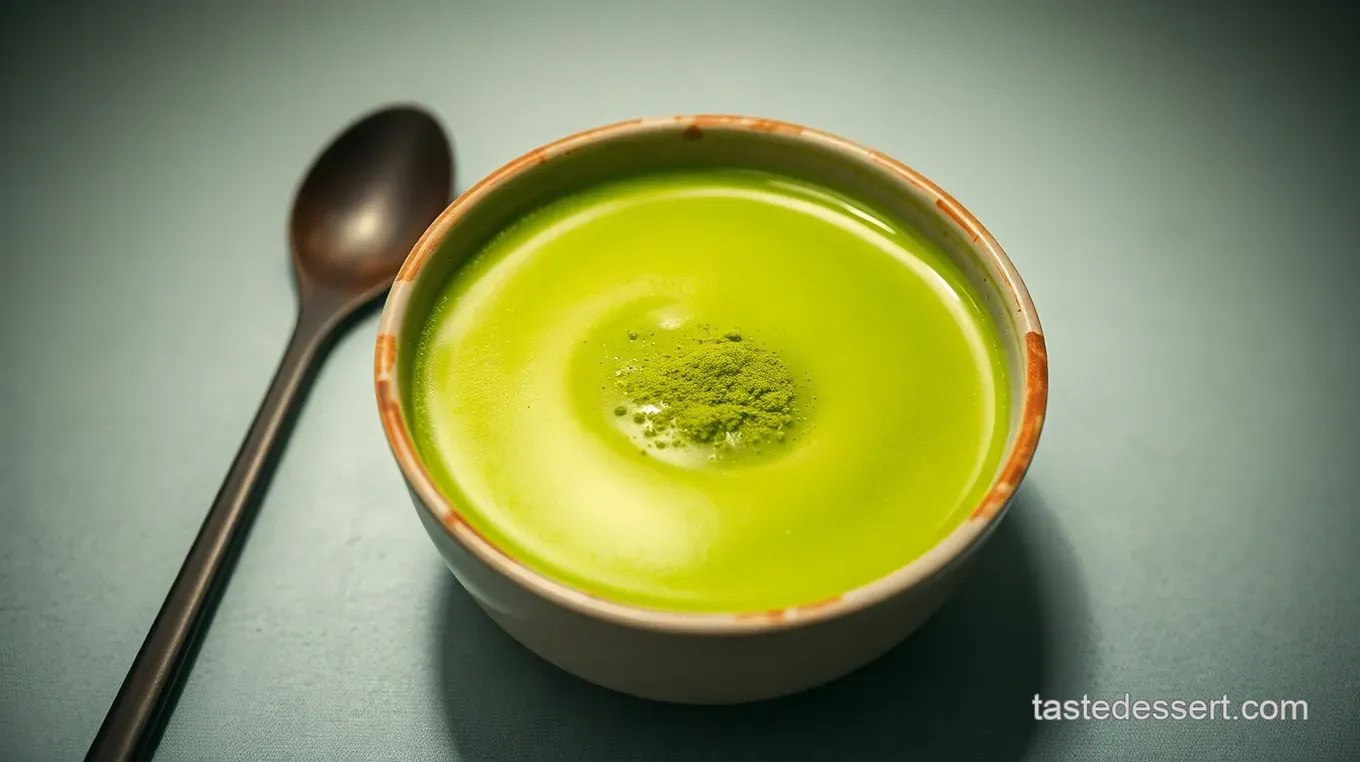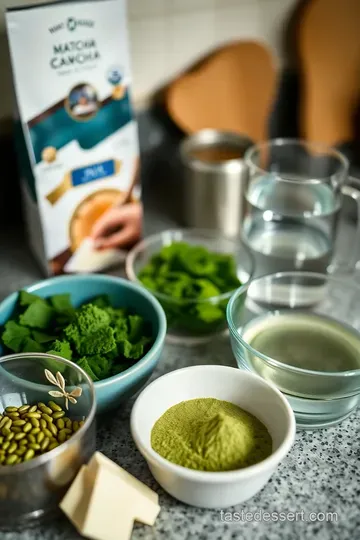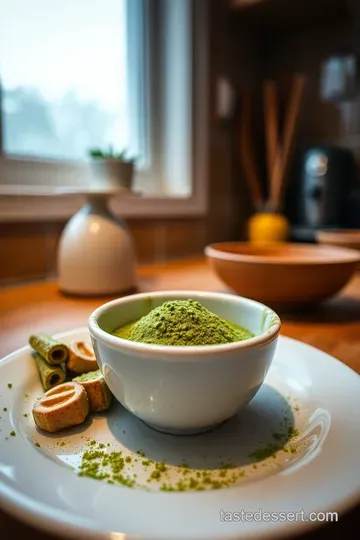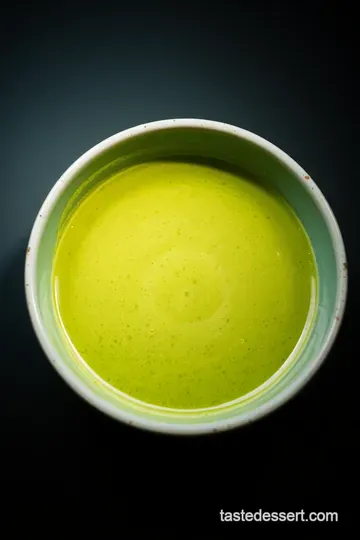Matcha Magic: Exploring the Caffeine Content in Japan’s Vibrant Green Powder
Curious about how much caffeine does matcha have? Explore this easy matcha tutorial and learn how to make matcha taste good while boosting your energy. Perfect for good matcha drinks and beginner recipes!

Ever wondered how much caffeine does matcha have? i remember the first time i tried a good matcha drink , and i honestly didn’t know what to expect.
I keep hearing about its calming alertness and the beautiful vibrancy of that green powder, but i was curious—just how much energy does it really pack? plus, knowing the caffeine level is key if you're trying to find matcha food recipes or looking for matcha drink ideas that won’t send you bouncing off the walls.
So, i started digging into it, and wow, i learned some pretty interesting stuff.
Matcha’s roots run deep in japanese culture. for centuries, it’s been used in tea ceremonies, admired for its rich umami flavor and unique cultivation process.
Instead of steeping leaves, they grow the tea plants in the shade for weeks before harvest. this shade-growing kicks up the chlorophyll and amino acids, giving matcha that bright green color and complex flavor profile.
Today, folks love it beyond japan—blended into smoothies, baked into treats, or infused into latte art. it’s become a modern superfood , especially with the rise of matcha strawberry drinks , which blend sweetness with that earthy punch.
Now, how much caffeine does matcha have? this is a question i see pop up a lot, especially from folks curious about energy boosts but also worried about the jittery side effects.
Well, here’s the scoop: per gram , matcha contains roughly 19-30 mg of caffeine . and that depends on the grade and how you prepare it.
A typical serving—say, one teaspoon (which weighs around 2 grams)—has about 38-60 mg of caffeine . that’s similar to a small cup of coffee, which has about 95 mg per 8 ounces .
So, while it might not hit like a double espresso, it certainly offers a solid caffeine kick.
What influences these numbers? well, quality makes a difference. ceremonial grade matcha usually has slightly different caffeine levels compared to culinary types, but generally, the differences aren’t huge.
How you prepare it also matters—adding more powder or using a more concentrated scoop boosts the caffeine content. plus, it’s good to keep in mind that how to make matcha taste good is part art and part science.
If you’re new to it, blending with hot water (around 175° f) helps keep the flavor smooth and mellow, rather than bitter and overpowering.
Of course, if you’re someone trying to limit caffeine intake or are caffeine-sensitive , knowing how much caffeine does matcha have can help you plan your day.
A cup in the morning can set you up for alertness without the crash later. or, for a fun twist, you can try to make strawberry matcha — blending the earthy flavor with some sweet, fresh berries—that's a favorite matcha drink idea .
Honestly, i love tossing a teaspoon of matcha into my smoothies or lattes because it’s such a versatile matcha food recipe .
Plus, if you want a mild boost, you can dilute it more—mixing with milk or plant-based alternatives makes a creamy, energizing matcha latte .
If you're curious about what does matcha taste like , it’s honestly an earthy, slightly grassy flavor with a hint of sweetness, especially when you’re clever with how to make matcha taste good .
It’s never overpowering if prepared well, and it pairs beautifully with good matcha drinks like a cozy latte or even a matcha strawberry drink .
Plus, it’s pretty forgiving—you can add vanilla, a dash of honey, or citrus zest for some fun variations.
So, whether you’re a novice just starting out or a seasoned ensoiast, understanding how much caffeine does matcha have helps you enjoy it safely and confidently.
It’s a wonderful, versatile matcha recipe food that can energize your day while giving you a little bit of that calming zen vibe—that’s what makes it so special.
Now that you’re a little more clued in on caffeine and matcha, let’s talk ingredients —it’s time to gather that vibrant green powder and see how you can turn it into your next favorite drink!

Essential Ingredients Guide for Matcha Magic
Alright, my fellow green tea ensoiasts! if you’re diving into the world of good matcha drinks or just curious about how much caffeine does matcha have , i’ve got you covered.
Because honestly, understanding the ingredients isn’t just for food nerds. it’s for anyone who wants to enjoy matcha’s unique flavor and get a good energy boost without going overboard.
So, let’s get real and talk ingredients like a couple of friends chatting over coffee.
Premium Core Components: The Building Blocks of Your Matcha Drink
First things first, quality matters . when you're talking about matcha food recipes and making that perfect matcha strawberry drink , you want the best stuff.
I swear, the difference between ceremonial grade and culinary grade matcha is like night and day. ceremonial grade has a vibrant, bright green color and a smooth umami flavor.
It’s perfect if you’re making how to make matcha taste good or whipping up some matcha drink ideas for friends.
A typical serving size for a good matcha drink is usually about 1 teaspoon (2 grams) . for measurements , in us cups, that’s roughly 1/2 tablespoon.
If you’re in europe, measure with a scale to get precise—about 2 grams.
Now, storage —keep your matcha in an airtight container, away from light and moisture. it keeps longer if you stash it in the fridge, especially if it’s a big jar.
Shelf life? usually about 1 year for high-quality matcha if stored correctly. as for freshness tips , always buy from reputable sources—look for vibrant green powder, no yellowish tint, and a fresh grassy smell.
Because, trust me, stale matcha just tastes like old shoes.
Signature Seasoning Blend: Giving Your Matcha That Wow Factor
When you’re thinking about matcha food recipes or even simple matcha tutorial videos, don’t forget about seasonings and herbs . classic pairings include ginger, vanilla, or citrus zest .
These boost flavor and make how to make matcha taste good a whole lot easier. for example, a splash of vanilla extract or some fresh lemon zest can turn a basic matcha strawberry drink into a refreshing, tasty treat.
Spice mixes like cinnamon or cardamom also vibe well, especially in cozy, cold-weather drinks. and to amp up flavor enhancers , consider adding a pinch of sea salt or a drizzle of honey—sometimes, just a little sweetens the deal.
Regional variations? totally! in japan, they sometimes add matcha with rice or red bean, but for us americans, blending with berries or even chocolate can create some epic matcha recipes .
Smart Substitutions: Keep Things Flexible and Fun
Let’s talk about alternative ingredients because life is full of surprises. ran out of matcha? no worries. you can swap in green tea powder or even matcha-flavored protein powder —great for a quick matcha food boost without fuss.
And hey, for folks watching caffeine intake, lower-caffeine options include blending less matcha or mixing it with more milk or water.
Want to shake things up? try matcha with coconut milk or switch to herbal teas for a caffeine-free vibe.
Emergency replacements ? if you’re in a jam, brewed green tea leaves can be a decent stand-in, but they won’t pack as much caffeine.
Btw, if you’re wondering how much caffeine does matcha have , it varies a lot depending on the brand and preparation method, but generally it’s about 38-60 mg in a typical 2-gram serving — kinda like half a cup of coffee.
Honestly, just enough to give you that good matcha drink buzz without throwing you over the edge.
Kitchen Equipment Essentials: Gear Up for Success
You don’t need a fancy chef’s arsenal, but a few must-have tools can make your matcha tutorial more fun. a good whisk is key—traditionally a bamboo chasen, but a small electric frother works too.
A measuring spoon or scale ensures you’re not going overboard on the powder.
Thinking about alternative equipment options , a high-powered blender can whip up a frothy matcha strawberry drink or a creamy matcha latte.
For storage? use airtight containers, and keep your matcha in a cool, dark spot. oh, and to make how to make matcha taste good , always sift your powder before whisking—lumps are the enemy!
Once you have your gear, make sure to prep your ingredients properly. for example, warm water around 175° f ( 80° c) is perfect—hot enough to activate all the flavors but not so hot that you burn your matcha.
So, now that we’ve covered core ingredients , seasoning ideas , substitutions , and equipment , you’re all set to dive into the world of matcha food recipes .
Trust me, once you understand how much caffeine does matcha have , you'll feel more confident choosing your perfect matcha drink.
Next up, i’ll walk you through the actual step-by-step instructions for making your dream matcha strawberry drink and mastering that iconic matcha recipe food .
Get ready to shake up your routine — because once you know all this, making your own good matcha drinks will become your new favorite thing!

Alright, so let’s get real about matcha . you’ve probably heard about how good it is and wondered, “how much caffeine does matcha have, anyway?” honestly, knowing that answer can totally change how you enjoy your good matcha drinks or spice up your matcha strawberry drink or matcha food recipes .
I remember trying a fancy matcha strawberry drink at that trendy brunch spot — and it hit me how energizing that little green powder can be.
Let’s start with the basics: matcha is a finely ground powder made from shade-grown tea leaves in japan. it’s been around for centuries and is super popular because of its rich umami flavor and calming alertness.
But what really makes it stand out? the caffeine. and if i’m honest, that’s the part i was most curious about when i first started experimenting with it.
So, how much caffeine does matcha have ? well, a typical teaspoon (that’s about 2 grams of matcha powder) packs roughly 38-60 mg of caffeine .
That’s quite a range because it depends a lot on the quality of your matcha — ceremonial grade tends to be a little more refined and consistent, while culinary is a bit more rustic but still tasty.
Comparatively, an 8-ounce cup of brewed coffee rings in at around 95 mg of caffeine , while black tea is usually around 47 mg for the same amount.
When i started making my own matcha strawberry drinks , i found that measurement is everything. use too little, and it might not give you that kick you’re looking for.
Use too much, and it can taste bitter — and honestly, i don’t want my mornings ruined by a mug that’s too strong.
I always keep a small scale in my kitchen, so i can measure the matcha exactly — more precision = better how to make matcha taste good .
It’s also good to remember that factors like caffeine levels can vary by brand and preparation method. for instance, a ceremonial grade matcha usually has a more balanced flavor and a bit more caffeine than culinary grades, which are perfect for baking or matcha food recipes .
If you're making a matcha latte or trying out matcha drink ideas , i’d suggest starting with one teaspoon and adjusting based on how energized you want to feel.
Now, let’s talk safety — because too much caffeine isn’t great for anyone, especially if you’re sensitive. experts recommend sticking to about 400 mg of caffeine a day for most adults.
That’s roughly 6-7 teaspoons of matcha, but remember, if you're adding milk or flavorings, it can dilute or amplify the effect.
If you’re curious how to make matcha taste good while still getting your caffeine boost, pair it with some vanilla or a dash of honey — trust me, it totally elevates the flavor.
Something i learned the hard way: don’t brew your matcha with boiling water. instead, aim for around 175° f (or about 80° c) .
It’s hot enough to activate all those amazing antioxidants but gentle enough not to scorch the leaves. i used to rush and pour boiling water because i was eager to enjoy my matcha strawberry drink , but that bitter aftertaste taught me patience.
This small step really makes a difference in matcha food recipes or your morning matcha drink ideas .
Once you’ve got your matcha prepared, keep an eye on its evenness and color — it should be vibrant green, not dull or yellowish.
A vivid shade is the mark of good quality and consistent caffeine levels. troubleshooting? if it tastes super bitter, cut back slightly, or check your water temperature.
Lastly, don’t forget about make-ahead options. you can prepare a batch of matcha powder whisked with water and store it in the fridge for a few days.
That way, in the morning, it's just a quick heat-up or shake-up to enjoy. plus, if you’re trying to see how to make strawberry matcha or experiment with other matcha food recipes , having your base ready makes everything way easier.
So, whether you’re looking for how much caffeine does matcha have to plan your day, or just trying to try to understand how it compares to your usual coffee, now you’re all set.
Next, i’ll fill you in on all the expert techniques to make your matcha truly shine — because, honestly, the little details are what make all the difference.
Up next: dive into the step-by-step process to perfect your matcha and learn all the troubleshooting tricks for that flawless, vibrant cup. Stay tuned!

Hey there! so, you’re curious about how much caffeine does matcha have ? great question, because it’s one of those things that confuses a lot of folks, especially if they’re new to good matcha drinks or just want to get their facts straight.
I remember when i first started experimenting with matcha—think trying to make it taste good enough to be a daily thing.
Spoiler alert: it took a little trial and error, but i learned a lot about its caffeine levels along the way.
First off, a little history. matcha’s been around for centuries in japan, used in traditional tea ceremonies and celebrated for its umami flavor and calming alertness.
It’s made from shade-grown tea leaves, which boosts chlorophyll and amino acid content. that’s part of why matcha has such a rich, slightly earthy taste—what does matcha taste like? think grassy, with a hint of sweetness, and a touch of bitterness if you overbrew it.
Now, onto the big question. how much caffeine does matcha have? well, it depends on a few things, but on average, for a typical teaspoon of matcha powder (about 2 grams), you’re looking at roughly 38 to 60 mg of caffeine .
That’s a pretty solid energy kick, but not as much as a strong cup of coffee, which packs about 95 mg per 8-ounce serving.
And if you’re wondering whether matcha is good for you as a good matcha drink, yeah—it's got antioxidants and other health perks, which make it a tasty, energizing pick-me-up.
The exact amount can vary depending on the grade of matcha— ceremonial grade tends to be more refined and might have a slightly different caffeine punch compared to culinary grade .
Also, how you prepare it matters: hot water temperature, steeping time, even the amount of powder. honestly, i used to overheat my matcha, which made it taste bitter and probably degraded some of the nutrients.
The trick? use water at around 175° f (hot but not boiling), and blend vigorously to get a nice frothy, smooth drink.
If you're into experimenting with matcha strawberry drink or other flavor combinations, just know that the caffeine content stays pretty consistent because it’s based on the matcha powder itself.
Still, it’s worth noting that how to make matcha taste good is mostly about good quality powder and the right prep.
Also, for anyone wondering, how much caffeine in matcha compared to coffee or black tea ? think of matcha as a nice middle ground—less jittery than coffee but enough to give you a focused alertness.
For those sensitive to caffeine, it’s good to know that a serving of matcha generally contains about 40-60 mg . that can be perfect for a morning boost without the crash, or an afternoon pick-me-up.
I like to add it into smoothies or even make matcha food recipes , like energy balls or protein bars, because it’s an easy way to get your caffeine fix without gulping down a giant mug of coffee.
Now, here’s a little pro tip: if you’re making a matcha recipe food like a matcha latte or smoothie, measure your powder carefully.
Use a kitchen scale if possible. it makes a difference, especially if you want a consistent caffeine dose. also, if you’re curious about how to make matcha strawberry or other matcha drink ideas , combining that with fresh strawberries or vanilla makes it taste amazing, and the caffeine content stays steady.
To wrap this up, remember. matcha is a fantastic way to get a gentle caffeine boost, paired with antioxidants and a unique flavor.
How much caffeine in matcha? roughly 38 to 60 mg per teaspoon—enough to keep you sharp for a few hours, but not so much that you’ll be bouncing off the walls.
It’s a beautiful, natural alternative to regular coffee or energy drinks, especially if you want to try some matcha strawberry drink or other creative matcha food recipes .
So, next time you’re wondering whether your green powder packs a punch, you’ll know it’s a smart, steady kind of energy.
Just remember, quality helps—go for high-grade matcha, get your prep right, and enjoy the vibrant taste and benefits. and hey, don’t be shy about experimenting with matcha drink ideas or making your own custom version — it’s all part of the fun!
Keep sipping, exploring, and enjoying the magic of matcha. You’ll be a matcha master in no time!
Frequently Asked Questions
How much caffeine does matcha have compared to coffee?
On average, a teaspoon (about 2 grams) of matcha contains roughly 38-60 mg of caffeine, while an 8-ounce cup of coffee typically has around 95 mg. So, matcha offers a more moderate caffeine boost, ideal if you're looking for sustained energy without the jitters.
Can I drink matcha every day without worrying about caffeine overdose?
Most people can safely enjoy up to 400 mg of caffeine daily, which is about 6-8 teaspoons of matcha. If you're sensitive to caffeine, start with smaller servings and listen to how your body reacts—matcha can be a gentle alternative to coffee.
What factors affect how much caffeine is in my matcha?
Quality matters—a ceremonial grade matcha usually has a slightly higher caffeine content and smoother flavor than culinary grade. Also, the amount of matcha you use and how you prepare it (more powder means more caffeine) will influence your cup's energizing power.
Are there any tips for reducing caffeine in matcha recipes for sensitive drinkers?
Yes! Use less matcha powder or dilute your matcha with more water or milk. You can also opt for lower-grade or flavored versions if you want a milder caffeine hit, or enjoy smaller servings throughout the day to spread out your energy boost.
What's the best way to store matcha to keep its caffeine and flavor fresh?
Keep matcha in an airtight container, away from light, heat, and humidity—think of it as the Japanese version of preserving fine tea. Stored properly, it maintains its vibrant green color, flavor, and caffeine content for several months.

Matcha Magic: Exploring the Caffeine Content in Japan’s Vibrant Green Powder Card

⚖️ Ingredients:
- N/A
- 1 teaspoon (2 grams) of matcha powder
- 1 cup (240 ml) of hot water
🥄 Instructions:
- Step 1: Introduce matcha and its cultural significance in Japan, highlighting its unique cultivation and processing methods.
- Step 2: Explain caffeine content basics, describing what caffeine is and its effects, including typical caffeine levels in various beverages for context.
- Step 3: Quantify how much caffeine is in matcha, referencing scientific studies and authoritative sources. Approximate caffeine content: per gram about 19-30 mg and per standard serving (2 grams): about 38-60 mg, comparing with coffee and black tea.
- Step 4: Discuss factors affecting caffeine levels in matcha, such as quality (ceremonial vs. culinary grade), serving size, and preparation method.
- Step 5: Address common questions about safe caffeine intake per day and whether matcha is suitable for caffeine-sensitive individuals.
- Step 6: Provide visual aids like charts comparing caffeine content of matcha vs. coffee/tea and infographics on measurement and serving sizes.
Previous Recipe: Homemade Coolatta: Refreshing Frozen Beverage Perfect for Summer
Next Recipe: When Does Burger King Serve Lunch? Your Guide to Fast Food Hours and Tips
